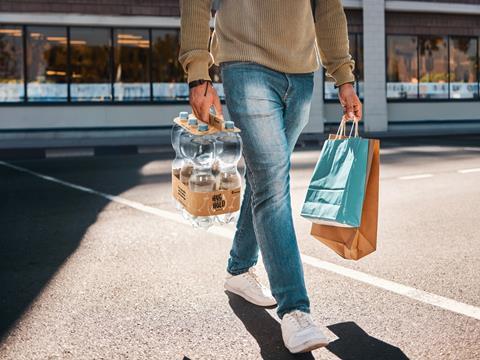
Mondi says that Hug&Hold – its recyclable, paper-based shrink wrap alternative – reduces carbon footprint by 43% compared to LDPE shrink wrap. We recently spoke with Jakub Vilánek, packaging innovation scale manager for flexible packaging at Mondi, to learn more.
Let’s start with some context on Hug&Hold – what is it and what are some of its end-uses? How is the solution made, and what is it made from?
Hug&Hold comprises two elements that enable the safe transport and stacking of beverage bottle bundles. The first element is a patent-pending 100% kraft paper sleeve that wraps around the bottles to hold them securely. Made from Advantage SpringPack Plus, it offers high tensile strength and can withstand enough weight to strap and stabilise the bottles during transport.
The second element is a corrugated clip that holds the bottles around the neck. The optional integrated handle means a bundle of bottles can be carried and transported easily. The consumer or retail customer can easily remove the individual bottles from the bundle, making it even more practical.
What are the key functionality differences between Hug&Hold and plastic alternatives? Is it as strong and is it more susceptible to water damage etc?
With Hug&Hold, Mondi is the first to manufacture and market a complete concept that offers a strong and stable solution, made from renewable and fully recyclable materials, suitable for existing paper waste streams across Europe.
I’d like to talk more about the LCA now – who conducted it, how was it done, and what were the results?
Mondi commissioned a critically reviewed and ISO-compliant life cycle assessment to evaluate the life cycle impact using the Environmental Footprint (EF) method. A total of 16 indicators were assessed, from raw material acquisition and production to end-of-life treatment (typical disposal in the EU27).
The assessment shows that Hug&Hold has a lower impact in the categories of climate change, fossil resource use, photochemical ozone formation, acidification, ionising radiation, water use and eutrophication of freshwater.
The total carbon footprint is 43% lower than the average LDPE virgin plastic shrink wrap and 15% lower than LDPE shrink wrap with 100% recycled content, reducing the climate change impact of the packaging while providing a robust solution for customers.
What steps did Mondi take to ensure that the results of the LCA were as objective and accurate as possible?
We regard our life cycle assessment as foundational to producing meaningful and actionable insights that support sustainability, efficiency and stakeholder trust. For the Hug&Hold LCA, we partnered with an established LCA consultancy to conduct the study. In addition, a panel of three independent experts conducted a critical review based on the requirements of ISO 14044.
The expert panel supported the study from the beginning and reviewed all phases, from the definition of the objectives and scope to the collection of primary and secondary data, to the results and conclusions.
If you liked this story, you might also enjoy:
How are the top brands progressing on packaging sustainability?
Sustainable Innovation Report 2024: Current trends and future priorities
Reuse vs. single use – which is better for the environment?
The ultimate guide to global plastic sustainability regulation


















No comments yet